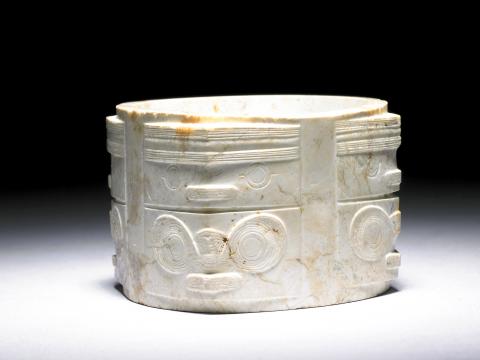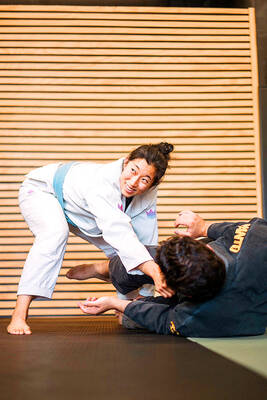Chinese Practice
瑕不掩瑜
(xia2 bu4 yan3 yu2)

Photo courtesy of National Palace Museum,Taipei
照片:台北國立故宮博物院提供
a blemish does not obscure jade’s luster
玉在中華文化中的價值,如同黃金和寶石在其他國家文化中的地位;這種對玉的使用和重視,可以追溯到新石器時代。有些玉石白色如凝脂、質感光滑、完美無瑕──被稱為「羊脂玉」;而其他玉石色彩變化微妙,給人無比的視覺享受,玉石中分布的雜質和深淺不一的化學成份「缺陷」,反倒增添其美感及興味。
在今中國東北遼寧省附近的新石器時代紅山文化中,閃玉被用來製成禮器和珠寶,這些物品只有上層社會才能使用;閃玉很硬,極難加工。新石器時代的良渚文化位於今上海附近,玉被製成禮器,如圓盤狀的「璧」──代表「天」,以及「琮」(音「從」)──外方內圓的中空柱體,代表「地」。璧與琮皆用於墓葬儀式,其形式至今未變。在東周時期,孔子及儒者便很尊崇玉──由於玉的特質,且玉代表了君子令人敬佩的品格。
《禮記》記載了周代的社會規範、施政及禮儀,其中的〈聘義〉一章,有一段子貢和孔子的對話,討論玉如此受重視的原因。孔子說,玉並不是因為稀有才珍貴,玉的價值在於其品質,及其在古人心目中的象徵意義:「溫潤而澤,仁也;縝密以栗,知也;廉而不劌,義也;垂之如隊,禮也;叩之其聲清越以長,其終詘然,樂也;瑕不掩瑜、瑜不掩瑕,忠也;孚尹旁達,信也;氣如白虹,天也;精神見於山川,地也;圭璋特達,德也。天下莫不貴者,道也。」(玉石溫和、潤澤有光彩,正如君子的仁德一般;它紋理細密而又堅實,就好像君子的智慧,心思細膩、縝密,處事周全;當玉石摔碎後,雖然也有棱角,卻不尖銳,不會傷人,如同君子之義,正直剛毅,卻以仁愛存心;垂掛著的時候,看似要跌落下來,象徵著君子的謙下恭謹;敲擊它的時候,會發出清澈激昂的聲音,最後則嘎然而止,與音樂的性德相似;雖然有斑點,但不會因此而遮掩它的優點,縱然它很美,斑點也如此顯而易見,如君子之忠,毫不掩飾;另外,玉的色彩從各個方面都可以看到,好比君子之信,表裡如一,也誠信不欺;它晶瑩透亮猶如白虹,與天道相應。而玉的精神可見於山川之中,與地相應。朝覲時,手執玉石所製之圭璋,自然合乎禮。天下無不以美玉為貴,這是道的顯現。)
「玉」這個中文字,是來自早期象形文字──三條橫線代表三片玉──用一條垂直的線串在一起。成語「瑕不掩瑜」中的「瑕」和「瑜」兩字,部首都是左邊的玉部,右邊的部分則是用來標示其發音。「瑕」字的意思是「玉石中的缺陷」;「瑜」字則指「精美的玉」。現今的成語「瑕不掩瑜」,其義同出處的原始意義,字面意思是「瑕疵不會掩蓋玉的光澤」,比喻「優點多過缺點」。
(台北時報林俐凱譯)
這部片無論是劇情、服裝、道具都十分考究,雖然有幾個穿幫鏡頭,但瑕不掩瑜,仍大受歡迎。
(Much research went into this movie’s script, costumes and props. Despite a number of minor anachronisms, the movie was generally well received.)
你的成績單可說是瑕不掩瑜,雖然數學因為計算錯誤被扣分,但其他科目的表現可圈可點。
(Your exam results are not perfect, but they’re good enough. You lost marks with mistakes in the math section, but you did really well in the other subjects.)
英文練習
the pros outweigh the cons
Jade has been used and prized in Chinese culture going all the way back to Neolithic times, and has been accorded the same kind of admiration and value given to gold and precious stones elsewhere. Sometimes, the stone has an unctuous, glossy quality, white and flawless — referred to as “mutton fat” jade; at others, it can be a visual feast of subtle transitions in color, interspersed with solid inclusions and chemical “flaws” at varying depths below the surface that only enhance its beauty and interest.
In the Neolithic Hongshan culture of NE China, around present day Liaoning Province, nephritic jade was used to make ritual objects and jewelry reserved for only the higher echelons of society, the hardness of the material making it extremely difficult to work; in the Neolithic Liangzhu culture, around present day Shanghai, it was used for ritual objects such as the bi disc — thought to represent the sky — and the cong tube, a cylinder with a round interior and square exterior, thought to represent the earth. Both bi and cong were used in ritual burials, and their form has persisted in Chinese crafts and arts ever since. In the Eastern Zhou, Confucius and his followers respected the stone for its qualities, and how these represented the admirable characteristics of the idealized Confucian gentleman.
In the pin yi chapter of the liji (Book of Rites), a collection of texts describing the social norms, administration, and ceremonial rites of the Zhou dynasty, we find a discussion between Zi Gong and Confucius himself on why jade is valued so much. Confucius says that rarity does not come into it; its value derives from its qualities, and what the stone symbolized to the ancients: “Soft, smooth, and glossy, it appeared to them like benevolence; fine, compact, and strong: like intelligence; angular, though neither sharp nor cutting: like righteousness; hanging down (in beads) as if it would fall to the ground: like (the humility of) propriety; when it was struck, it would yield a note clear and prolonged, yet terminating abruptly: like music; its flaws did not conceal its beauty; nor its beauty its flaws (瑕不掩瑜,瑜不掩瑕): as with loyalty; its internal radiance emanating on every side like good faith; yet it is bright as a rainbow, like heaven; exquisite and mysterious, appearing in the hills and streams, it is like the earth; standing out conspicuous in the symbols of rank, it is like virtue; jade is esteemed by all under the sky, like the path of truth and duty.”
The Chinese character for jade, 玉, is an early pictogram of pieces of jade — the three horizontal lines — strung together. In 瑕不掩瑜, the character 瑕 and 瑜 both contain the radical for jade on the left, the right side being a phonetic indicator, pronounced xia and yu, respectively. The word 瑕 means “a flaw in jade”; the word 瑜 means “fine jade.” The phrase 瑕不掩瑜 comes down to us complete, as an idiom meaning, literally, “a blemish does not obscure jade’s luster” and, figuratively, “the pros outweigh the cons.”
(Paul Cooper, Taipei Times)
I realize the car’s not perfect, but there is much to recommend it. For all its faults, I still think we should buy it.
(這輛車不是十全十美,但優點非常多。縱使有這些缺點,但絕對值得買。)
My new apartment is old, but it has character. I would say the pros outweigh the cons.(我新搬進的公寓雖然舊,但是很有特色。我覺得它瑕不掩瑜。)

Historians are rethinking the way the Holocaust is being presented in museums as the world marks the 80th anniversary of the liberation of the last Nazi concentration camps this month. Shocking images of the mass killings of Jews were “used massively at the end of World War II to show the violence of the Nazis,” historian Tal Bruttmann, a specialist on the Holocaust, told AFP. But in doing so “we kind of lost sight of the fact that is not normal to show” such graphic scenes of mass murder, of people being humiliated and dehumanized, he said. Up to this

A: Brazilian jiu-jitsu, known as “BJJ,” has become more and more popular. Even Hollywood stars like Halle Berry and Tom Hardy are obsessed with it. B: Some Asian stars, such as Taiwanese actor Eddie Peng and South Korean actor Lee Joon-gi, have also practiced this martial art. A: BJJ is not just a martial art, but also a combat sport. B: I’ve always wanted to try it, but I’m worried about getting injured. A: Diana Wang, a US doctor of physical therapy, is holding a BJJ seminar at PMA Brazilian Jiu-jitsu in Taipei Friday night. Let’s go check out how we

When people listen to music today, they typically use streaming services like YouTube or Spotify. However, traditional formats like vinyl records have regained popularity in recent times. Vinyl records are circular discs that store music in grooves on their surfaces and are played on a turntable. As the turntable’s needle runs along these grooves, it picks up vibrations and translates them into sound. The history of vinyl records dates back to the late 1800s, but material and technological challenges delayed mass production until the 1950s. Despite early versions having short playtimes and poor sound quality, vinyl records introduced a new era

A: Actually, Brazilian jiu-jitsu is particularly good for small people like you. B: Really? How so? A: According to Diana Wang, a US doctor of physical therapy, the BJJ’s purpose is to help smaller, weaker people defend themselves by using various techniques, such as leverage. B: That sounds interesting. What time does Dr Wang’s BJJ seminar begin tonight? A: The event is scheduled for 7:30pm at PMA Brazilian Jiu-jitsu in Taipei. Admission is free, but donations are welcome. A: 其實你的個子比較小,很適合練巴西柔術呢。 B: 真的嗎?為什麼? A: 據美國理療醫師王幼瑞博士說,巴西柔術的概念是讓弱小的人,也能利用槓桿作用等技巧防身。 B: 真有趣,王醫師的巴柔研討會幾點開始? A: 今晚7點半在「台北巴柔運動館」,免費入場自由樂捐唷! (By Eddy Chang, Taipei Times/台北時報張迪)